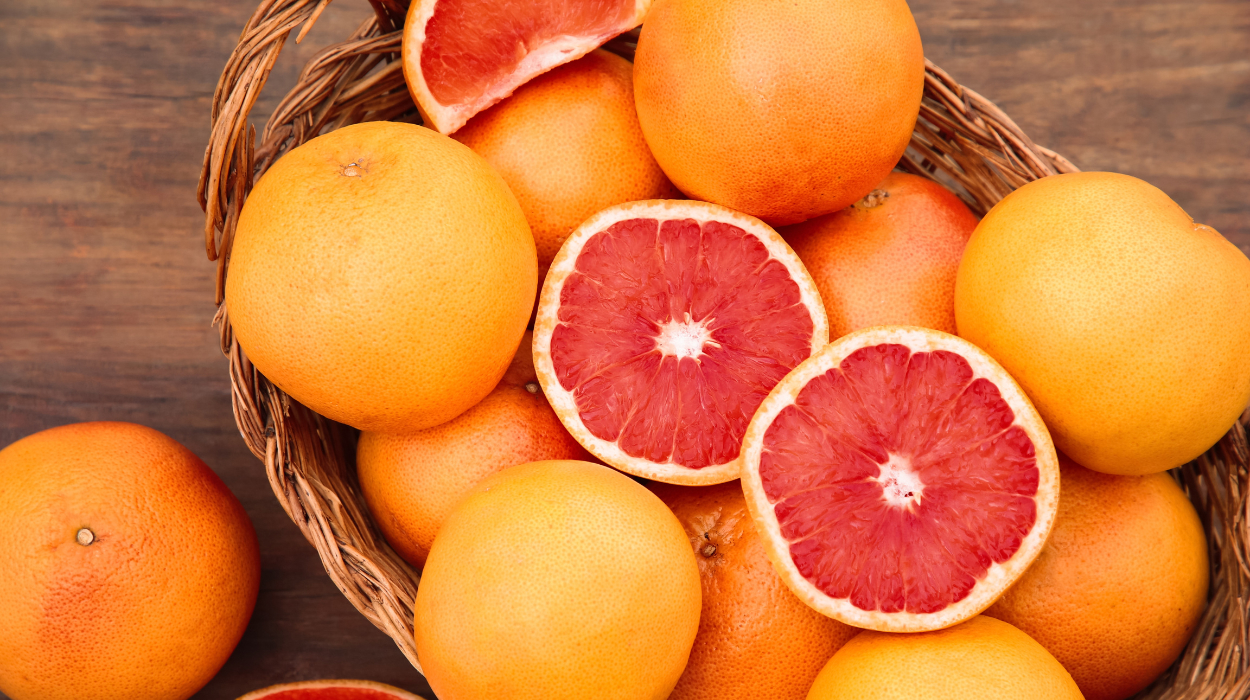It’s time to stop throwing away your grapefruit peels — and it’s time to start eating more grapefruit, too.
We often throw away the peels without giving it a second thought. We don’t even realize all the fantastic grapefruit peel benefits we’re missing out on.
By saving the peels, you can take full advantage of everything this fruit offers. Read on to learn how to use grapefruit peels for total body health and how they can keep your home smelling citrusy, fresh, and clean.
What Are The Benefits Of Grapefruit Peel?
Grapefruit peel is beneficial for
- Anti-inflammatory actions.
- A digestive aid.
- Weight management.
- Healthy skin.
- A natural household cleanser.
Benefits Of Grapefruit Peel

From aiding in weight management to serving as a wonderfully clean and delicious-smelling home cleanser, citrus peel can do more than you realize.
Anti-Inflammatory
Grapefruit peels[1] are rich in beneficial compounds called flavonoids[2] and polyphenols.[3] Flavonoids have anti-oxidative, anti-inflammatory, and anti-carcinogenic properties. They also are considered anti-mutagenic, which means they can reduce the risk of genetic mutations linked to poor health.
These compounds[4] are great to add to your diet as they help reduce oxidative stress from free radicals and inflammation in the body — which is the root cause of many chronic conditions. This includes cardiovascular disease, arthritis, and some types of cancer. For example, cancer prevention research shows that citrus peel[5] can block the spreading of cancer and kill cancer cells.
Citrus flavonoids may even have neuroprotective benefits[1] since they’re involved in neuronal activities. This includes effects on your mood and behavior, such as depression and cognition.
Digestive Aid
Like the fruit, grapefruit peels[6] are also rich in fiber[7] and prebiotics, such as the soluble fiber pectin.
This combination feeds beneficial microorganisms,[8] bacteria, and yeast in the gut, creating a healthy intestinal flora that supports optimal health. A healthy gut also provides a biological barrier and inhibits the growth of disease-causing organisms, preventing diarrhea and enhancing immunity — while allowing you to absorb nutrients better.[9]
Overall, grapefruit peels are a great way to increase your daily fiber content while decreasing the environmental waste of healthy food resources.
Weight Management
The phenolic extracts from grapefruit peel affect enzymes related to diabetes and hypertension. These extracts may slow the digestion of carbohydrates[10] and prevent blood sugar spikes.
The natural sugars provided and their ability to not spike your blood sugar may even help prevent sugar cravings. That means you might eat fewer calories overall, which can lead to a caloric deficit for weight loss. Just be sure to limit candied grapefruit peel since this can be full of sugar.
Thanks to its fiber content, grapefruit peels may also help you keep you fuller for longer. Overall, a diet rich in fiber[8] can decrease the risk of obesity, type 2 diabetes, and other metabolic disorders.
Experts recommend 25 to 35 grams of fiber[11] per day for optimal health and weight management. One serving, half of a whole pink or red grapefruit, including the peel, has 2 grams of fiber.[12]
Healthy Skin
Vitamin C is famous for skincare, thanks to its protection from oxidative stress.[13] This stress can lead to wrinkles, fine lines, and a dull complexion.
Half a medium grapefruit provides 100% of your daily value of vitamin C[14] at 48 milligrams.[12] Its peel is also extremely high in vitamin C,[15] with 113 milligrams[16] per 100 grams.
Vitamin C is also necessary for collagen production. Collagen[17] is a protein that maintains your skin’s firmness and elasticity. Grapefruit peel’s high vitamin C content boosts your collagen synthesis by stabilizing and creating collagen.
Natural Household Cleanser
Beyond the health benefits of grapefruit peel, it can be used as a natural household cleanser. Its citric acid is a natural disinfectant, cutting through grease and stains. Its natural aroma and essential oil also create a fresh, clean, citrusy scent.
You can make a homemade cleaning solution by boiling grapefruit peel in water or infusing it in vinegar. Not only does this reduce the usage of harsh chemicals in your home and the environment, but it also repurposes what would otherwise be food waste.
Taking a few minutes to transform grapefruit peels into a healthy home cleanser is a simple, eco–friendly way to keep a fresh and clean home.
Ways To Use Grapefruit Peel

If eating grapefruit peel raw sounds unpleasant, don’t worry. There are plenty of ways to add grapefruit to your day.
- Cooking: You can add citrus fruit peel zest to your favorite savory dishes or desserts. It will add a hint of citrus flavor and its many health benefits. Like you would drizzle olive oil on top of vegetables, consider zesting lemons, oranges, or grapefruits for extra antioxidant properties.
- Cosmetics: Use dried grapefruit peel as a natural exfoliant in a homemade scrub. You can also infuse it into oils for a hydrating mask.
- Supplements: You can get boiled grapefruit peel benefits by seeping the peel in hot water to create a refreshing tea. You can even buy powdered fruit and vegetable supplements, but the whole food source in moderate amounts is usually the safest option.
- Household cleaning: Create your homemade eco-friendly cleaner within a few minutes. Infuse grapefruit peel with vinegar for a spray, or use the peels as a natural scrubber on your kitchen or bathroom counters.
Safety Precautions
Grapefruit can interact with a long list of medications.[18] If you have a health condition or take any medication, always check with your healthcare provider before adding it to your diet.
Pregnant or breastfeeding and postmenopausal adults should also avoid eating grapefruit in large amounts. There isn’t enough information to know if grapefruit is safe in amounts above average for these populations.
One serving size[12] of grapefruit is 154 grams, approximately half a grapefruit.
If you can’t eat grapefruit, ask your doctor what other fruits and vegetables you can have. You can also consider the best green powders, like green powder, to get your daily dose of antioxidants.
The Takeaways
Grapefruits aren’t great just for their pulp; the rind is full of holistic benefits for your health and your home. It can reduce inflammation and oxidative stress, aid weight management, keep skin plump, and keep your home clean and fresh.
If the taste is too bitter, grate the rind into your meals and desserts. Also, dry boiling the peels with water for a full-bodied tea. Just be sure to keep in mind that grapefruit can interact with certain medications and health conditions, so speak to your doctor first before adding it to your routine.
Frequently Asked Questions
Grapefruit peels are rich in vitamins and antioxidants, making them anti-inflammatory for our bodies. They also help support healthy skin, improve digestion, and potentially act as a weight management aid. You can also use them for their natural cleaning properties.
While it is uncommon, you can eat a small amount of raw grapefruit peel. However, it’s usually best to use it as a zest when cooking.
Rubbing grapefruit on your face might provide your skin with some of its vitamin C content. Vitamin C is famous in skincare products because it can help even skin tone, reduce acne, and create a brighter complexion.
It’s okay to eat the pith of a grapefruit. It’s rich in fiber and nutrients — just be aware that it tastes bitter.
Boiling grapefruit peels releases their essential oils and compounds into the water. This can create a fragrant solution that you can use for cleaning or even as a tea if made in a safe amount.
Yes, you can make tea with grapefruit peel. It’s usually dried first and then steeped to make a citrusy, slightly bitter tea. It may aid digestion and provide antioxidants.
 Evidence Based
Evidence Based
